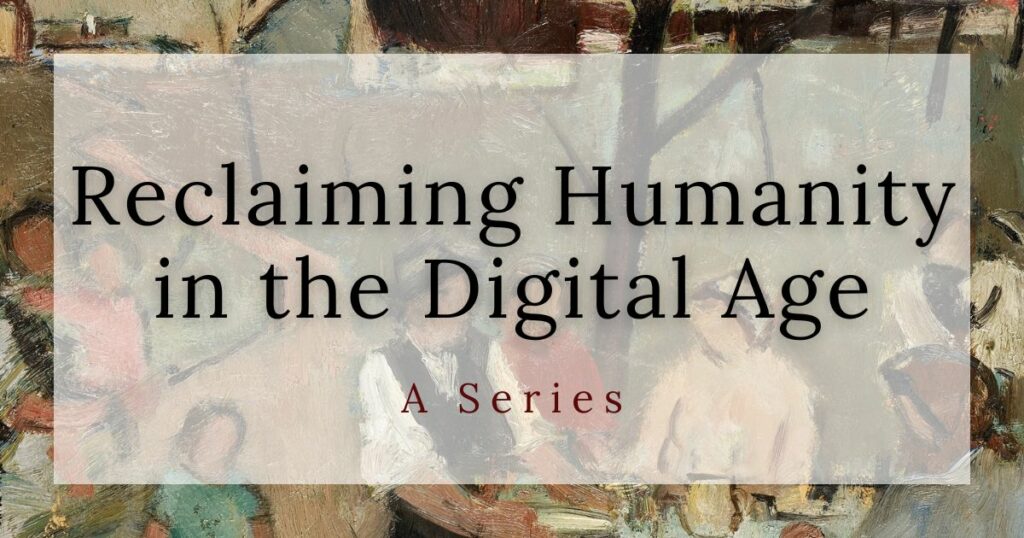This is the fourth installment in a six-part series, “Reclaiming Humanity in the Digital Age.” Check back for more installments soon.
By Joshua Pauling
Part 1 of this series established why it’s time to take action regarding the ubiquitous role of digital devices in our lives, Part 2 explored some core principles for parenting, and Part 3 offered some ways to counteract the unique challenges faced by those coming of age in the digital world.
Now, Part 4 focuses on why this is not just a “kids these days” problem. The challenges cross generational lines. Adults too have been reshaped by digital technology in unhealthy ways. But adults are uniquely positioned to model what constitutes a humane and flourishing life. They also can play a vital role in setting norms, providing guidance and establishing boundaries as leaders, employers, employees and more.
Adults, Too
Today, there is widespread concern about what screens do to the developing brains of children and adolescents. But adults are not immune to the pull of the screen and its detrimental effects. Surveys show that, on average, adults spend 4–6 hours a day on their smartphone and check their phone around 200 times per day. That means adults are spending roughly 75 full days a year — two and a half months! — on their smartphones. And even the self-reported impacts of this are sobering. Almost half of Americans admit to having a problem with digital addiction and over half of Americans want to cut down on phone usage in order to improve their mental health, increase their attention span, get better sleep, or improve their physical health.[1] Clearly, all this device usage is affecting our brains and our bodies.
Add to these sobering statistics two more realities: 1) Many professions in the modern global economy require near constant engagement with an internet connected screen; and 2) Lines between work and the rest of life are easily blurred because so much of our work can be done from a smartphone and from home. Given these two facts of life, it is no surprise that before we even realize it, the internet-connected device swallows up everything else.
We adults may have more executive function and impulse control than children and adolescents, but devices and apps are often designed to hack our attention and our dopamine response. This means it’s very possible to revert back to an infantile condition where we have little impulse control or ability to mute background stimuli. As our brains become hijacked by constant distraction and driven to a frenetic pace, we start to resemble the child who doesn’t know what to attend to.
This erosion of attention leads to everything from overstimulation to lack of impulse control to the colonization of our focus by commercial interests. It can also lead to profound loneliness, as we become unable to enjoy the meeting of minds that comes from joint attention sharing. The more we give in to distraction and chaotic alerting, the more our executive functions atrophy. Neurologically, we become like babies whose orienting networks are not yet under control of the executive functions, lost in a sea of chaotic alerting.[2]
Return to Our Divine Design
This series seeks to anchor our response to digital technology in God’s design for us as embodied beings with body and soul, and with inherent creaturely limits (Gen. 1–2). With this foundation in mind, consider the following three suggestions:
1. Protect your attention and focus.
The triune God designed us to be in one place at one time, with senses that can attend to what is in our immediate surroundings. The online world clashes with this design: online, it seems that we can be in multiple places at once, doing multiple things at once, all disassociated from our bodies and the place and people right around us. Multitasking becomes the norm in the digital world. But studies show that multitasking is really a myth.[3] You actually get worse at multitasking the more you do it, because it trains you to seek distraction and decreases your attention span.
To protect your attention and focus, you might consider turning your phone or computer back into a one-use tool: Use it to do one thing at a time. When you need to do email on your computer, only do email. When you need to use Microsoft Word, only use Microsoft Word and close all the other windows and tabs. Consider taking social media off your phone, so you don’t mindlessly use it (and if you really need social media, access it on your computer at designated times). And so on. When you are done with each task, be done with it until the next period of time set aside for that activity. As Cal Newport has argued, these types of practices can greatly increase productivity and our ability to accomplish meaningful, deep work.[4]
To foster deeper attention and focus, the philosopher of technology Albert Borgmann highlights the importance of focal practices. A focal practice is something that requires joint concentration of the mind and body. Playing a musical instrument is a focal practice, as are many traditional hand crafts, skills and trades that require precise bodily movements and mental focus. Reading books, exercising, gardening, preparing a meal and eating together, and all sorts of other activities can be focal practices. The key is to engage with the world and with each other in ways that develop a skill and require our full attention in real time and space with real things and real people.[5]
2. Establish clear digital boundaries.
The Holy Trinity also designed us with limits. Even before the fall, human bodies had inherent limitations as creatures of God. They also had external limitations — they were not to eat of the tree of the knowledge of good and evil (Gen. 2:17).
Limits are not bad. In fact, they enable us to flourish in accord with our design. We should keep this in mind when it comes to digital boundaries. Adults need boundaries around devices too, because willpower is a limited resource and we are fighting against companies that are racing to the bottom of our brain stems. We can’t resist the addictive aspects of our devices by willpower alone.
Two of the most basic ways to institute healthy boundaries is to compartmentalize time and compartmentalize space. Set time frames around when you can be online or engage in other screen-based activities to ensure there is also time for richer activities that recalibrate us around our divine design. The same holds true for space. Designate certain places where digital devices are off-limits.
Anna Lembke, author of Dopamine Nation, explains why we need such boundaries. “One of the biggest risk factors for getting addicted to any drug,” writes the Stanford psychiatrist, “is easy access to that drug. When it’s easier to get a drug, we’re more likely to try it. In trying it, we’re more likely to get addicted to it.” The same is true with digital drugs. Even small barriers to access can be all that’s needed to end bad habits and develop new ones.
We need barriers and boundaries to help us “press the pause button between desire and action,” as Lembke puts it, until new habits are formed. We need nooks and crannies for contemplation that birth new insight. We need sanctified times and spaces for silence that bring forth peace. We need alcoves for awkward boredom that blossom into creativity.
3. Serve someone.
God designed us for relationship with Him and with others (Gen. 2:18, Matt. 11:28–29, 1 John 1:1–4). The perfect love and relationship between the persons of the Holy Trinity overflows in creation and redemption as we are brought into the divine life through the work of Christ that is made ours through Word and Sacrament. The creative love and radical hospitality of the Trinity then pours forth through us as well, as we love and serve one another.
Inviting others to share a meal together, to cross the threshold of our homes, to labor together in joint projects, to share in one another’s sufferings — all of these actions bring us outside ourselves into a deeper experience of love and purpose. And all of it is patterned after our King and Master, Jesus Christ, who came not to be served, but to serve, who invited the sick and outcasts to His table, who entered into our suffering in His own person, and still extends the invitation to His banquet today (Matt. 9:10, Luke 5:29, Rev. 19:6–9).
In Part 5, we will pick up on this note: how Christ and His church are a refuge in the digital age. The church has the ultimate answers to what it means to be human in Christ, the One who was fully and truly human and who brings us with Him into resurrection life, by grace, through faith, on account of His perfect life, death and resurrection.
[1] Trevor Wheelwright, “Cell Phone Usage Stats 2025: Americans Check Their Phone 205 Times a Day,” Reviews.org, Jan 1, 2025, reviews.org/mobile/cell-phone-addiction; Alexus Bazen, “Cell Phone Statistics 2025,” Consumer Affairs, Mar 20, 2025, consumeraffairs.com/cell_phones/cell-phone-statistics.html; “Are You Addicted to Your Phone? American Phone Usage and Screen Time Statistics,” Harmony Healthcare, Jan 8, 2025, harmonyhit.com/phone-screen-time-statistics; “Mobile Fact Sheet,” Pew Research Center, Nov 13, 2024, pewresearch.org/internet/fact-sheet/mobile.
[2] For more on the importance of attention and the dangers posed by digital distractions, see Chapter 30 of Robin Phillips and Joshua Pauling, Are We All Cyborgs Now? Reclaiming Our Humanity from the Machine (Emmaus, PA: Basilian Media and Publishing, 2024).
[3] Robin Phillips and I document the research around the ineffectiveness of multitasking in our book Are We All Cyborgs Now? (Basilian Media, 2024).
[4] Newport develops these arguments in three books, A World Without Email, Deep Work and Digital Minimalism. As an example, he argues that many times email actually slows work down, because what once used to be a two-minute conversation in the office or on the phone, now is extended over multiple emails that span a longer period of time and eat up more attentional resources from the people involved because it does not occur all at once.
[5] For more on Albert Borgmann’s ideas, see Chapter 17, Are We All Cyborgs Now?.





